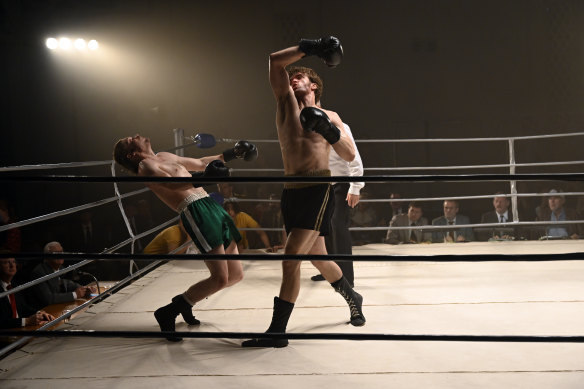By Sandra Hall
KID SNOW ★★★½
(MA) 127 minutes
Kid Snow is the kind of film the Australian industry used to produce – a fondly mounted excursion into recent outback history energised by the urge to recreate a world that no longer exists. Forget about political correctness. Director Paul Goldman and the film’s writers have no desire to give us a revisionist version of the past. The most refreshing thing about their work is the thoroughness with which they have steeped themselves in the morals and customs of their chosen time and place.

Billy Howle in the boxing drama Kid Snow.
It’s 1971 in Western Australia, and tent shows are still crisscrossing the country, with boxing billed as their main attraction. It’s a rough-and-ready life and Kid Snow (Billy Howle) and his older brother Rory (Tom Bateman) had hoped to leave it behind to become boxers on the professional circuit, but a car accident put paid to that ambition. It killed their father and broke Rory’s leg with crippling results. Now, he manages the show while the Kid carries on with a job he’s come to despise because every fight reminds him of his failures.
It’s been almost 18 years since Goldman’s last feature film, the underrated Suburban Mayhem, an absurdist tabloid fable animated by a scarily good performance by a 22-year-old Emily Barclay. But it, too, displayed Goldman’s love of a well-furnished tale. It was about a gleeful brand of wickedness inadequately camouflaged by the boringly domestic. This one comes up with an equally paradoxical setting, juxtaposing the grubbiness of the tent village against the beauties of the pastel-tinted landscape that surrounds it.

Kid Snow (Billy Howle, left) takes a hit from Hammer (Tristian Gorey) in Kid Snow.
The carnival comes alive at night when Garry Phillips’ cinematography casts it in earthy tones edged with shadows softened by dust and the smoke of hand-rolled cigarettes. Props and people have an equally well-worn look. They’ve been on the road for far too long.
The plot takes off when the Kid is talked into fighting Hammer (Tristan Gorey), the boxer who helped to damage his budding professional career 10 years earlier. It’s a twist that leads to a few too many contrivances, but none of them are as unlikely as the part written for Phoebe Tonkin. She plays a former exotic dancer from Kings Cross who’s trying to make a new life for herself and her young son. Tonkin never quite fits into the film’s narrative architecture, even though she puts in a great performance and takes a major part in the action. A bitter row erupts between the Kid and Rory after both become fascinated by her.
Sadly, the Kid isn’t nearly as charismatic as some of his fellow travellers, the roustabouts who keep the show going. Led by Indigenous actors Mark Coles Smith and Hunter Page-Lochard, they form a close-knit group that serves as a cheer squad and irreverent Greek chorus. They become the conscience of the piece and their camaraderie is one of the film’s chief pleasures – yet more proof of Goldman’s ability to create a well-lived-in world.
Kid Snow is released in cinemas on September 12.
Find out the next TV, streaming series and movies to add to your must-sees. Get The Watchlist delivered every Thursday.